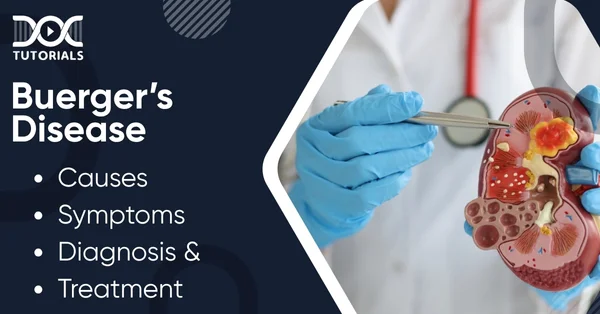Buerger’s Disease | Causes, Symptoms, Diagnosis, and Treatment

Buerger’s disease, also known as thromboangiitis obliterans, is an uncommon but severe illness that mainly affects the blood vessels in the arms and legs. This disease results in pain, tissue damage, and, in extreme situations, gangrene.
It is most frequently observed in young or middle-aged tobacco users and is often challenging to diagnose and treat. If you’re a medical student preparing for the NEET PG exam, it is crucial to understand the causes, symptoms, and available treatments to excel in your examination and medical career.
Keep reading for a detailed insight.
What is Buerger’s Disease?
Buerger’s disease is a non-atherosclerotic, segmental inflammatory disease that affects the small and medium-sized arteries and veins. It mainly involves an individual’s feet and hands. Inflammation causes blood vessels to narrow or become blocked, lowering blood flow to tissues and causing pain, ulcers, and possibly tissue death (gangrene).
This disease is most common among young and middle-aged men who use tobacco, but considering the increasing smoking rate, women are also diagnosed with Buerger’s disease.
What are the Causes of Buerger’s Disease?
Though the actual cause of Buerger’s disease is not known to the experts yet, tobacco and blood vessel inflammation are common connections found in most affected people.
Here are some of the most common causes of Buerger’s disease are as follows:
- Tobacco
Nearly all patients have a history of cigarette smoking or other tobacco use (including chewing tobacco). Even minimal tobacco exposure can worsen the disease.
- Genetic Susceptibility
Some populations (such as those of Ashkenazi Jewish, Indian, Korean, and Japanese descent) show higher rates, suggesting a genetic predisposition.
- Autoimmune Mechanisms
Some researchers believe Buerger’s Disease may be an autoimmune disorder, where the immune system mistakenly attacks blood vessels.
- Other Factors
Chronic gum disease and trauma to hands or feet may also contribute. The causes of Buerger’s disease include the following:
- Age (typically under 45 years)
- Male gender (though the gap is narrowing)
- Heavy tobacco use
- Certain ethnic backgrounds
- Chronic gum disease
What are the Symptoms of Buerger’s Disease?
Buerger’s Disease symptoms usually develop gradually and often appear on the hands and feet. Common symptoms of Beurgers disease include the following:
- Severe pain in the legs, arms, hands, or feet, often during rest or exercise (claudication).
- Fingers or toes may appear pale, red, or blue, especially in response to cold (Raynaud’s phenomenon).
- Affected limbs may feel numb or tingly.
- Hands and feet may feel unusually cold.
- Unrecovered sores or ulcers may develop on fingers or toes.
- Swelling along veins, sometimes with visible blood clots under the skin.
- In advanced cases, tissue death (gangrene) may develop, necessitating amputation.
What is the Diagnosis of Buerger’s Disease?
There is no single definitive Buerger’s test for diagnosing the disease. Doctors begin by asking about the history of tobacco use and the symptoms. Following this, the doctor performs a few tests to diagnose this disease, such as:
- Blood Test
Since other conditions, like peripheral artery disease, can cause similar symptoms, doctors ask for blood tests. It helps assess blood flow and rule out these alternatives. Blood tests are also performed to exclude other diseases like diabetes, lupus, or clotting disorders, helping narrow down the diagnosis to Buerger’s disease.
- Allen Test
It examines the circulation in the hands. During this test, the patient makes a tight fist to force blood out, and the doctor compresses the arteries in the wrist. If the hand takes longer than normal to regain its colour after releasing the pressure, it may indicate blood flow issues associated with Buerger’s disease.
- Imaging Tests
This includes angiograms, CT (computed tomography) scans, or MRIs (magnetic resonance imaging), which can reveal blockages or narrowing in blood vessels in the arms and legs.
What are the Treatment Options for Buerger’s Disease?
There is no cure for Buerger’s Disease, but treatment focuses on halting disease progression by managing symptoms. Listed below are a few of those considerations:
- Complete Tobacco Cessation
This is the single most effective intervention. Quitting all forms of tobacco, including cigarettes, cigars, chewing tobacco, and nicotine products, is crucial to prevent further vessel damage. Even minimal exposure can worsen the disease.
- Medications
Here are some of the medicines that can help manage Buergers disease:
- Vasodilators to improve blood flow
- Blood thinners to reduce clotting risk
- Pain management medications
- Adequate Care
Proper care of ulcers and sores prevents infection. Avoiding cold exposure also helps protect hands and feet from freezing and reduces symptoms.
- Surgical Options
Bypass surgery or procedures to restore blood flow (rarely effective in small vessels) can help manage Buerger’s disease. Amputation may be necessary in severe cases of gangrene.
- Supportive Measures
Proper foot and hand hygiene, regular exercise, and management of other health conditions are necessary to prevent further complications. Moreover, terminating tobacco use can lead to symptom improvement and, in some cases, disease remission.
FAQs About Buerger’s Disease
- Can Buerger’s Disease affect organs other than the limbs?
Buerger’s Disease primarily affects the small and medium-sized arteries and veins in the arms and legs. It rarely involves vessels supplying other organs.
- Is Buerger’s Disease hereditary?
While a genetic predisposition is suspected, especially in certain ethnic groups, no specific hereditary pattern has been identified.
- Is second-hand smoke a risk factor for Buerger’s Disease?
Exposure to second-hand smoke may increase the risk or worsen the disease; therefore, complete avoidance is recommended.
- What is the long-term outlook for people with Buerger’s Disease?
The prognosis depends mainly on tobacco cessation. Continued tobacco use leads to worsening symptoms and a higher risk of amputation, while quitting can halt progression and improve quality of life.
Conclusion
Buerger’s disease is a preventable and manageable condition with early diagnosis and proper treatment, particularly through tobacco cessation. Awareness of its symptoms and causes can significantly improve outcomes and prevent severe complications.
If you are an NEET PG aspirant, it is necessary to understand Buerger’s disease, which is a crucial part of your syllabus. With DocTutorials, you can get professional learning experiences in your convenient space. We provide top-grade learning materials through video lectures, resolve doubts, and take tests to assess your improvement.
Join our NEET PG course to learn from the experts and excel in the exam!
Latest Blogs
-

NEET SS Exam 2024: Analysis, Key Dates, Counselling
The NEET SS 2024 exam kicked off on March 29, 2025. Over two days and two slots, candidates across 13…
-

NEET PG Registration 2025: An Essential Guide For Exam Prep
The NEET PG registration, which is conducted online, is a crucial step in the exam process. Filling out the NEET…
-

NEET PG Syllabus 2026: A Must-Have Complete Guide for Exam Success
The NEET PG Syllabus acts as one of the foundation stones for aspiring postgraduate medical students like you who are…




